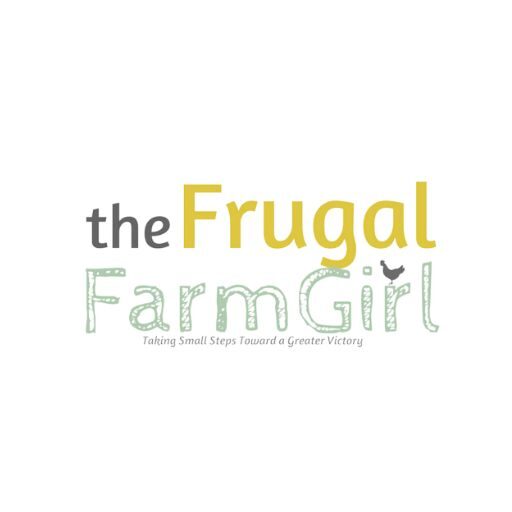Are you considering starting a garden but don’t have the space for one? Then, container gardening may be the perfect option for you!
Growing your plants in containers allows you to create a garden that fits any space. And container gardening has several other benefits, too.
Container gardening is an excellent way to get fresh produce without the commitment of a traditional yard. Plus, it’s easy and possible no matter where you live!
Many benefits come from container gardens, so let me tell you about them today.

Weather does not limit you.
When you want to plant outside, you have to follow the planting guidelines for the state that you live in. Your efforts could be completely wasted if you don’t because the plants won’t grow.
By using container gardening, you can decide what you want to plant and when you want to grow it. In addition, you can control the temperature, the growing season, and the time involved.
No more waiting until the weather determines what you’re able to do. So, if you decide that you want to create a container garden, you can do that right in the middle of winter if you wish.
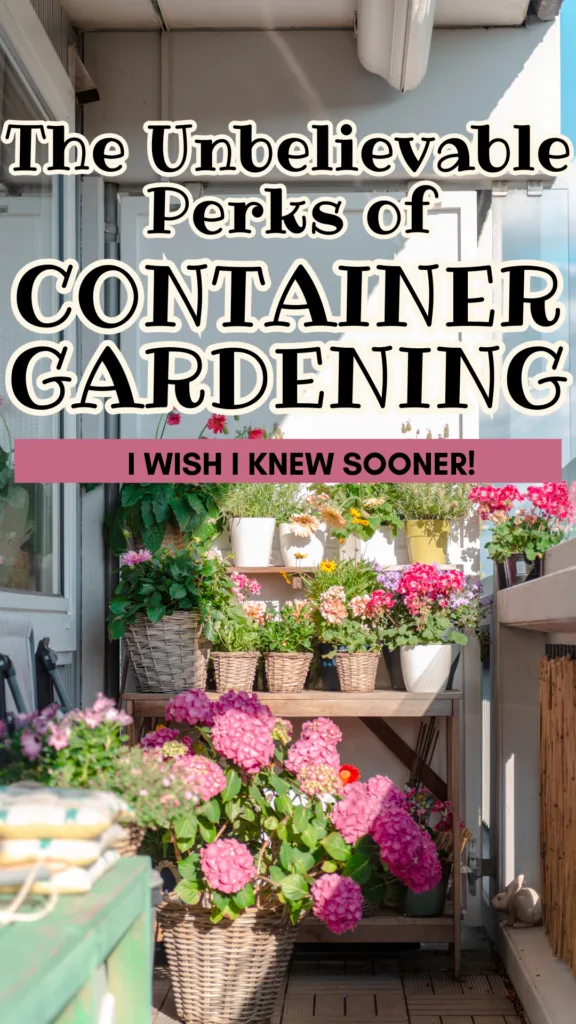
Read or Pin for later: How to Start Seeds Indoors.
You can build your garden using seeds or plants. Another plus is that you won’t be toiling outside in sweltering heat trying to take care of the things you’ve planted.
You can do it all right from your home if you build your garden inside.
But that doesn’t mean you have to stick with having a garden indoors only. Plenty of people create container gardens right outside on their porches. If you have a suitable climate for it, you can do it inside or out!
Read or Pin: Cheap Ways to Decorate Your Porch Patio With Flowers
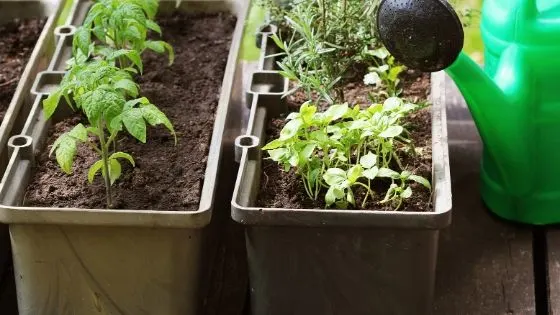
You Don’t Have to Be an Expert
Outdoor gardening isn’t as easy as one might believe. This is why many novice gardeners struggle to have success with traditional gardening. You have to watch out for several things that can get in the way of your success.
If you are new to gardening, be sure you avoid garden burnout.
Whatever items you plant will die if the soil’s acidity isn’t right. Unfortunately, finding the right soil balance isn’t always a matter of just adding nutrients – because too much of a good thing can also harm plants.
Pests and animals such as rabbits and deer are a massive problem with outdoor gardening. So you would have to ensure that your outdoor garden was inaccessible to pests and animals, which is challenging.
You won’t have that struggle with container gardening. You can get a potting mix that’s already perfectly blended to use. The beauty of getting a premade potting mix is you don’t have to add much to the soil again for a while.
With container gardening, you won’t be faced with having your garden overrun with weeds, either.
Container gardening makes it easy to ensure that your plants get the exact amount of sun and moisture, so you won’t have to figure any of that out in conjunction with weather patterns.
There’s also no worrying about sticking to a set limit with your planting in container gardening because your garden can be as big or as small as you like.
You can use whatever size containers you’d like to use. This works well for people who don’t have a lot of yards, if any. There are no limitations on you when you garden this way.
If you want to have a small garden, you can. But you can also have a large one. You can have single containers or more than one. You can set them up in one area or scatter them throughout your house.
You can grow them on your front or back porch or a balcony. You can situate the containers if they’re small enough on window sills. These containers can sit in spots where the sun pours in from a door or a window.
The plants will still be able to thrive. You can grow things like vegetables, herbs, flowers, and fruits in small or large containers. Grow just enough for what you want – or some to share.
Read or Pin: How to grow a flower garden you’ll be proud of
If you want to, you can even create a mini indoor greenhouse. You’ll discover that not all of your plants can grow under the same conditions, so you’ll have to customize the soil, watering, and light needed.
With container gardening, that’s an easy remedy. You can put plants with similar needs together and not worry about accidentally damaging the plants beside them like in traditional gardening.
When you create your garden, you can sort the items by the needs of the plants.
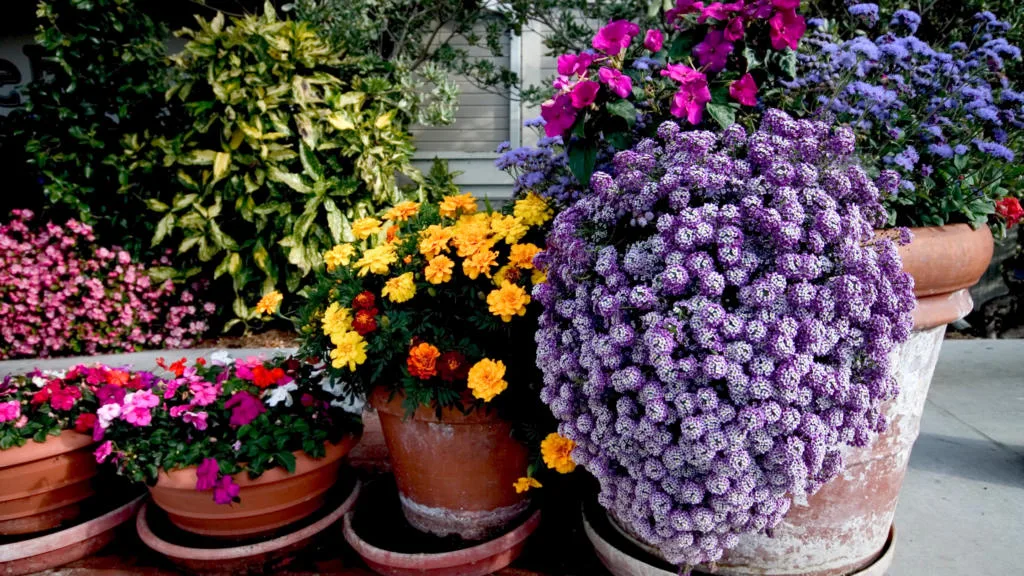
You’ll Save Money by Container Gardening
Regular outdoor gardening can be pretty expensive. We all know I’m all about how to save money when it comes to everything we do.
There are many tools you have to buy, and the cost of plants for filling a more extensive plot than you would with container gardening.
You don’t have to use a lot of water when you do container gardening. When you water a container, it gets to the root system, where it needs to go.
You won’t have to worry about the water sloughing off or that it will evaporate – which is what frequently happens in traditional gardening.
The amount of water you’ll need is minimal compared to traditional gardening. Plus, you can set it up to self-water your container garden. You’ll have to be careful not to go overwater a plant if you water it yourself.
If the plant’s roots are continually saturated, it will eventually kill it. One thing that many people love about container gardening, besides how easy it is, is that you can use whatever container is healthy for the plant.
That means using a container doesn’t have to cost you a penny. You can find free ones to use, or you can repurpose containers that you already have. For example, you can plant container gardens in old dresser drawers or wine barrels.
You can plant different types of items in spaces that are large enough to be divided so these can serve as multi-purpose planters. For example, you can use toolboxes or wheelbarrows. Tin tubs also make great planters.
You can use ceramic pots or plastic pots. The ideas are endless! The only thing that you must be careful with is to make sure that whatever container you use has a way for water to escape and the roots to get air.
- Choosing Containers for your garden
- Choosing Plants for your container garden
- How to find the best spot for your container garden
- 6 Reasons Container Gardening is the Best
Follow me on Pinterest for more ideas!
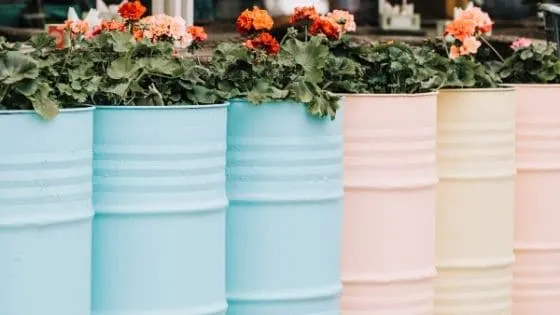
A Container Garden Is Better for Your Physical Needs
A traditional garden can be quite lovely. But it also requires a great deal of physical stamina. It’s not just toiling under the sun that can be difficult for some people.
It’s not even that you’ll have to keep an eye out for weather that’s too cold for your plants to survive.
Most people consider traditional gardening a gentle way to grow food or flowers. But that’s not the case at all. Whatever it is that you plant outside in a garden plot, you’ll have to do a lot of bending and stooping because you can’t take care of that kind of garden standing up.
You’ll also need to kneel to get to weeds and get low enough to inspect for pests. You may have to hold that position while you pull out the weeds or remove any problems.
It might be difficult for you to do all that is bending and stooping. After just ten or fifteen minutes, you’ll feel the ache in your lower back. With a container garden, you can set it up so that it’s convenient for you to get to and that it’s better for you physically.
If you have trouble bending over, you can arrange your containers to be at waist level. That way, taking care of your garden is a breeze—no more back-breaking stretching and trying to care for plants.
When your garden reaches maturity, you’ll find that it’s a lot easier on you when you’ve arranged your containers to be at the best angle and height for your physical needs. Then, all you have to do is remove the food items.
Check out what plants are the best to start with container gardening HERE.
You’re Not Stuck with One Design
Once you’ve put plants into the soil in a traditional garden, if you change your mind about how they’re arranged or have a problem with how they’re grouped, pulling up the plants can be significant.
It can be physically and mentally draining. Sometimes, you won’t realize that the garden isn’t working until a few days or weeks have passed. By then, uprooting and rearranging the plants might kill the less hardy ones.
When you have a container garden, you don’t have to do any significant rearranging if something isn’t working for you. Instead, you can relocate the plants’ containers or get a different container in place of the one you feel isn’t working for you.
You can even create a themed container garden using things like fairies or gnomes. If you’d like to make a themed container garden but need some inspiration, you can always check out Pinterest gardening pins.
Because your garden will be in containers, you can create them year-round or switch them up to match special events, such as having Easter lilies on a more prominent display or showcasing your holiday or hobby plants.
These would be plants such as a Christmas cactus. If you’re new to container gardening, you’re going to want to get plants known for their durability because you may have a bit of a learning curve to grow the plants successfully.
Check out my favorite blogger’s site here, all about micro gardening and the benefits.
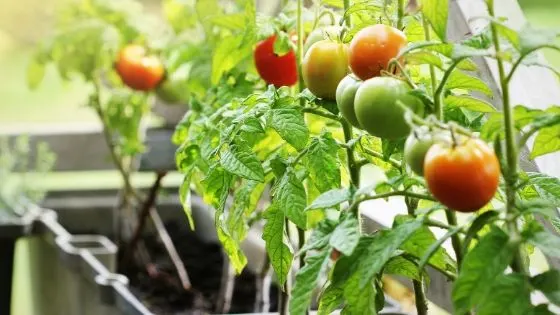
Container Gardening Success Tips
Before you design your container garden layout, you’ll need to decide which plants you’ll buy. Then, plan how to group the plants that need more hours of sunlight together.
You can put these in individual containers or together in one. Some people use stacked containers so that while the plants are grouped, they’re not actually in the same pot.
A good rule of thumb to remember is that if the plant produces something edible that’s not leafy, it’ll need more sun than some plants.
If you can’t get all your sunlight-needing plants into place in the sunlight you have to work with, you’ll need to consider an alternative light source to grow healthy.
Read or Pin: The Ultimate Garden & Outdoor living Gift Guide.
Know ahead of time how much access to water your plant needs. Depending on the variety you choose, some plants may need very little to survive.
If you give too much water to a plant that barely uses any, you’ll damage the plant or create an atmosphere for fungi to grow. At worst, the plant will wilt and then die.
It’s best to hide the watering instructions within the container somewhere out of sight so that you can check if you forget. But the best way to test whether or not the plants need to be watered is to push your finger below the top layer of soil.
Many beginning gardeners make the mistake of just checking the top layer, and if it feels dry, they water the plant. However, just because the top layer of soil is dry doesn’t mean the lower levels are.
Water on the top soil evaporates faster than water more profound into the ground. So one sign that a plant isn’t getting the correct amount of water is a change in the color of the leaves.
If the leaves on the plants start to turn yellow, check for both over and under-watering. You’ll also need to check the soil now and then. If the soil isn’t aerated enough, it becomes compact.
When that happens, your plants don’t get the correct amount of air. You can quickly aerate the soil by poking something into it, such as a fork, or using the tines on a gardening fork.
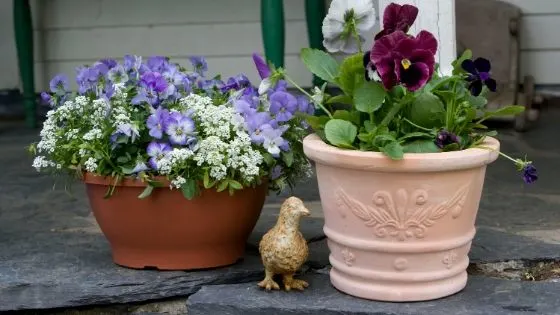
As Your Garden Grows, Avoid These Common Mistakes
Once your container garden has been established, it can be easy to get used to them. But gardening is an ongoing hobby, and your plants still need TLC to continue to thrive.
To ensure that your garden stays viable, you’ll want to avoid some common container gardening mistakes. Temperatures that are too hot or cold are among the biggest mistakes that people make.
It’s easy to assume that your plants must also be because you’re comfortable. However, whether your containers are located inside or outside your home, you’ll still need to watch the temperature.
Getting started with seeds? Check out these mistakes to avoid
You’ll want to take action before conditions become unfavorable for your plants. If your containers are plastic and the temperatures are high outside, your plant’s roots are being exposed to even higher temperatures because of the plastic.
Pots made of plastic allow more heat to pass through to the plant. Plants outside containers don’t just absorb heat from the top down; they also absorb it from the bottom up – which means the roots feel that heat reasonably quickly.
Read: How to Choose the Best Containers for Your Container Garden
So you’ll have to move the containers or sit them on a wet surface if they’re outside. Another mistake is neglecting to deadhead flowering plants. You have to remove dead blooms for the plant to grow well.
Not doing so impacts future blooms. Choosing suitable soil for the plants is essential. One kind of soil doesn’t necessarily fit all the kinds of plants you have.
To save on costs, some people try to use regular outdoor soil just like they’d use for an outdoor garden, but that doesn’t work with container plants.
Garden soil alone isn’t enough. It has to be mixed to create a healthy environment for your plants. Unfortunately, some container gardeners make a common mistake is not re-potting the plants.
Read or Pin: How to Start a Compost Pile
Depending on the plant, some plants grow faster than others, so you may need to re-pot within a year or two. However, there are signs you shouldn’t ignore that signal when the plant requires re-potting.
One sign is that the plant’s roots become visible at the bottom of the container. If you can see sources, it’s time to re-pot. Another sign you may notice is that the water runs right out when you water the plant.
While this can be a sign of overwatering, it can also be a sign that there’s been so much root growth the ratio of root to soil is out of balance. You can also check if a plant needs to be re-potted by gently grasping the plant close to the root base and lifting it.
A plant needing re-potting will have roots that wound around the soil, binding the plant. When you lift it from the container, the roots will often have bound the plant so tightly that the soil remains packed together in the shape of the pot.
Another benefit of container gardening is it’s a great way to grow healthy food or beautiful plants for your entire family to enjoy. In addition, they’re cost-effective and are great space savers for those who want to foster a green thumb but don’t have the area for an entire garden.
